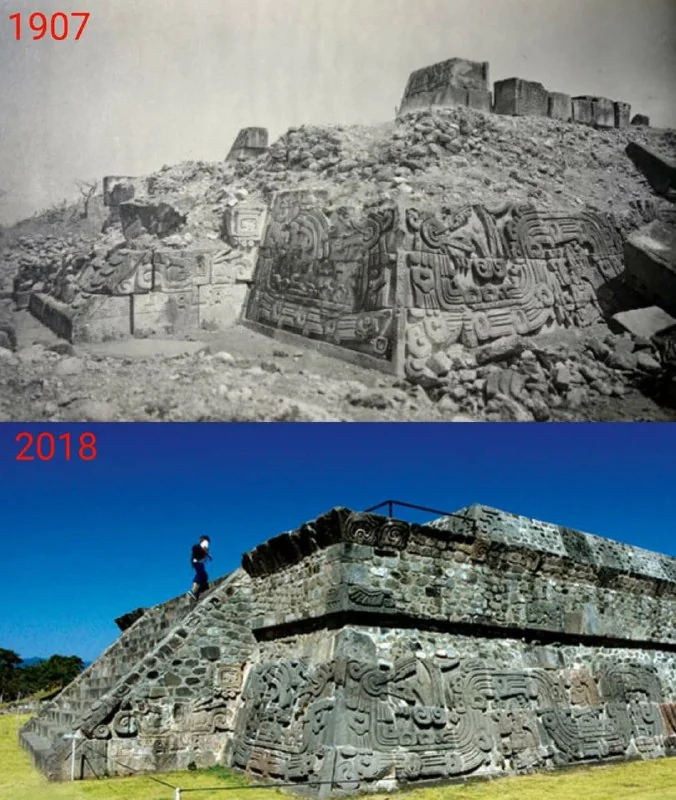Introduction to the Pyramid of the Plumed Serpents
Nestled in the ancient city of Xochicalco, Mexico, the Pyramid of the Plumed Serpents is an extraordinary testament to the ingenuity of Mesoamerican civilizations. Built between 650 and 900 AD, this iconic structure reflects the rich spiritual, artistic, and astronomical traditions of its time. Adorned with intricate carvings and symbolic imagery, it stands as a key piece in understanding the cultural and cosmological significance of Xochicalco.

Historical Context of Xochicalco
Xochicalco as a Cultural Crossroads
During its peak, Xochicalco was a vibrant city strategically located in central Mexico. Following the decline of Teotihuacan around 650 AD, Xochicalco emerged as a cultural and political hub that facilitated the exchange of ideas between neighboring civilizations, including the Maya, Zapotec, and Mixtec.
This city was not just a trade center but also a focal point of religious activity, with monumental architecture that showcased its builders’ artistic mastery and deep cosmological insights. The Pyramid of the Plumed Serpents exemplifies this synthesis of cultural influences.
Architectural and Artistic Brilliance
The Plumed Serpent Symbolism
The pyramid’s most striking feature is its detailed carvings of plumed serpents, representing Quetzalcoatl, the feathered serpent god. Quetzalcoatl was revered as a deity of wisdom, wind, and creation, embodying the harmonious connection between the heavens and the earth. These carvings depict serpents winding across the stone, their feathers flowing with lifelike detail—a visual metaphor for divine transcendence.
Reliefs Beyond Serpents
The reliefs on the pyramid go beyond the serpents, incorporating depictions of celestial beings, priests, and astronomical symbols. These elements suggest that the pyramid served multiple purposes: as a spiritual sanctuary, a record of cosmic events, and a ceremonial space for observing celestial alignments.

Cosmic Alignments and Astronomical Significance
Solar Phenomena
The Pyramid of the Plumed Serpents is intricately aligned with solar events. During specific times of the year, sunlight illuminates particular carvings, reinforcing its role as an observatory and ceremonial site. This alignment reflects the builders’ sophisticated understanding of celestial movements and their integration of astronomy into daily life and religious practice.
Ritual and Cosmology
The connection between architecture and astronomy at Xochicalco is a hallmark of Mesoamerican traditions. Rituals held at the pyramid likely coincided with solstices, equinoxes, and other key cosmic events, underscoring the civilization’s spiritual emphasis on maintaining harmony between humans and the cosmos.
Legacy of Xochicalco and Its Pyramid
A Testament to Mesoamerican Ingenuity
The Pyramid of the Plumed Serpents stands as a testament to the intellectual and artistic achievements of Xochicalco’s builders. Its detailed carvings, symbolic representations, and cosmic alignments reveal a deep understanding of not only art and architecture but also astronomy, theology, and social organization.
A UNESCO World Heritage Site
Recognized as a UNESCO World Heritage Site in 1999, Xochicalco continues to captivate scholars and visitors alike. The pyramid offers a unique glimpse into the dynamic interplay between Mesoamerican cultures, inviting us to explore their spiritual connection to the natural world and the cosmos.

Conclusion
The Pyramid of the Plumed Serpents is more than a monument; it is a masterpiece that encapsulates the cultural and spiritual essence of Xochicalco. Its artistic splendor, cosmological significance, and enduring legacy invite us to marvel at the ingenuity of ancient civilizations. As we uncover its mysteries, the pyramid continues to inspire awe and a deeper appreciation for Mesoamerican heritage.
